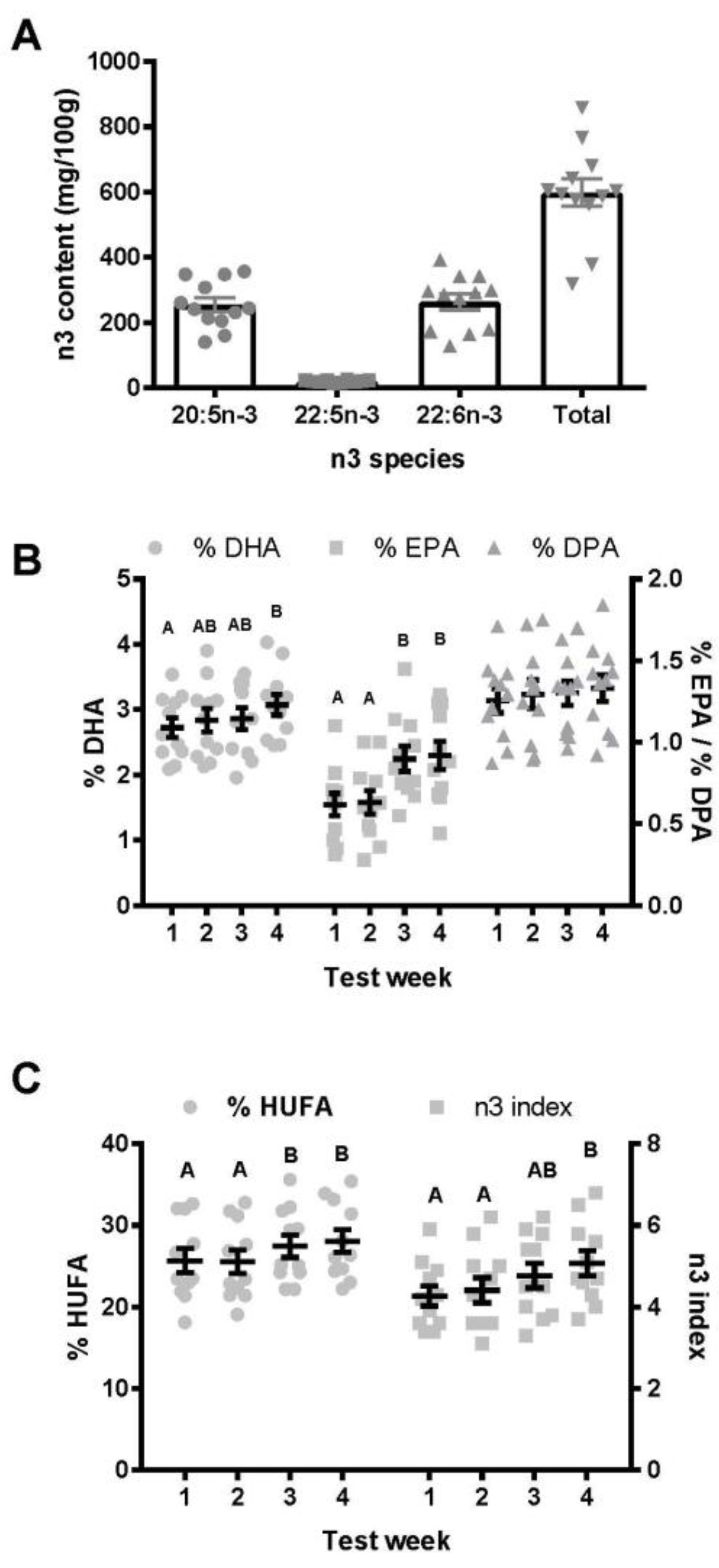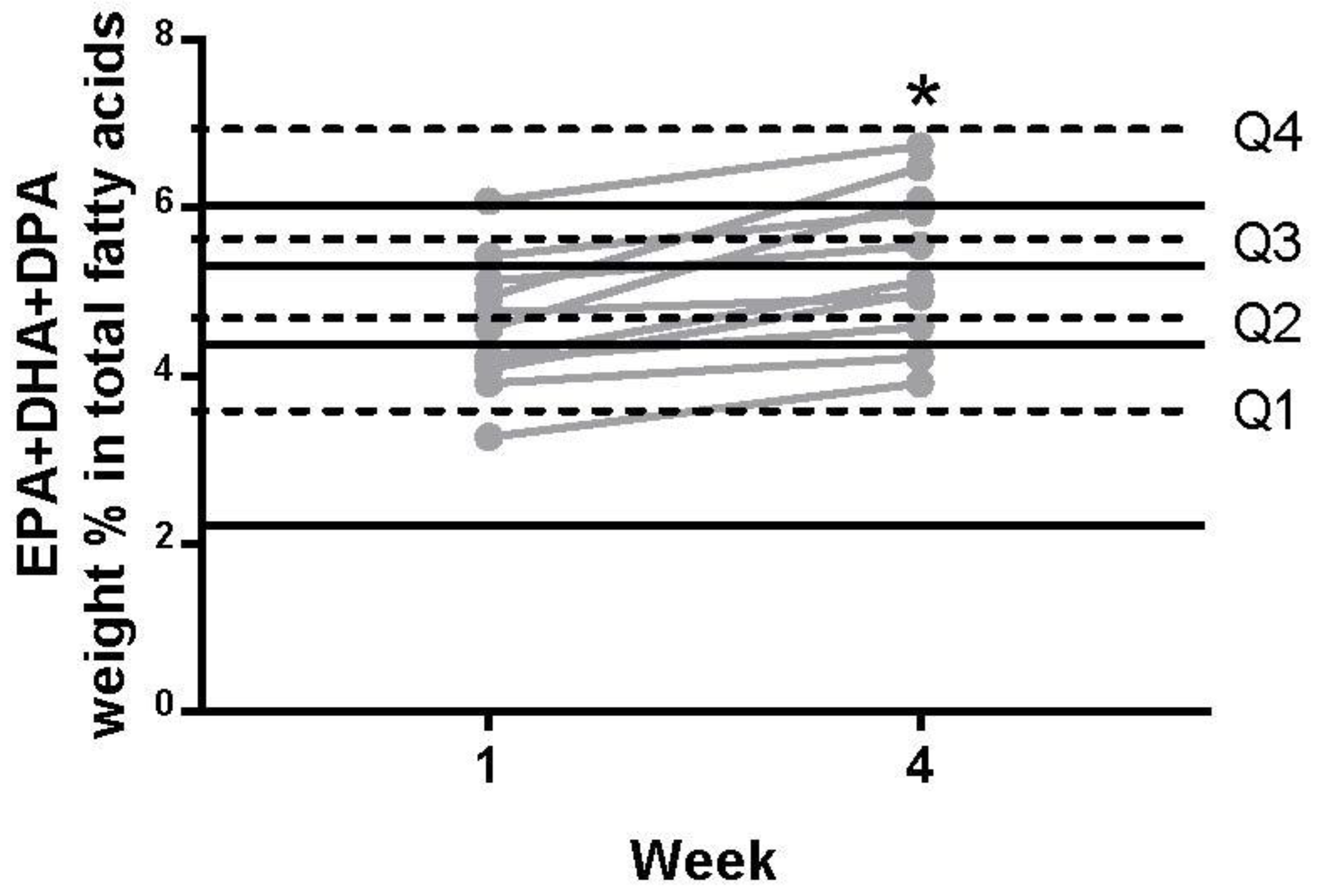Mussel Consumption as a “Food First” Approach to Improve Omega-3 Status
Abstract
1. Introduction
2. Methods
2.1. Participants
2.2. Diet Analysis and Blood Sampling
2.3. Design
2.4. Macronutrient Calculations
2.5. Mussel Preparation
2.6. Baseline Measurements
2.7. Blood Spot Analysis
2.8. FAME Analysis of Mussel Samples
2.9. Statistical Analysis
3. Results
3.1. Subject Characteristics and Diet
3.2. Mussel Omega-3 Content
3.3. Whole Blood Omega-3 Levels and Omega-3 Index
4. Discussion
Author Contributions
Funding
Conflicts of Interest
References
- Authority, E.F.S. Scientific Opinion on Dietary Reference Values for fats, including saturated fatty acids, polyunsaturated fatty acids, monounsaturated fatty acids, trans fatty acids, and cholesterol. EFSA J. 2010, 8. [Google Scholar] [CrossRef]
- NHS. Fish and Shellfish. Available online: https://www.nhs.uk/live-well/eat-well/fish-and-shellfish-nutrition/ (accessed on 7 November 2018).
- Micha, R.; Khatibzadeh, S.; Shi, P.; Fahimi, S.; Lim, S.; Andrews, K.G.; Engell, R.E.; Powles, J.; Ezzati, M.; Mozaffarian, D.; et al. Global, regional, and national consumption levels of dietary fats and oils in 1990 and 2010: A systematic analysis including 266 country-specific nutrition surveys. BMJ 2014, 348, g2272. [Google Scholar] [CrossRef] [PubMed]
- Brunner, E.J.; Jones, P.J.; Friel, S.; Bartley, M. Fish, human health and marine ecosystem health: Policies in collision. Int. J. Epidemiol. 2009, 38, 93–100. [Google Scholar] [CrossRef] [PubMed]
- Mozaffarian, D.; Rimm, E.B. Fish intake, contaminants, and human health: Evaluating the risks and the benefits. JAMA 2006, 296, 1885–1899. [Google Scholar] [CrossRef] [PubMed]
- Worm, B.; Barbier, E.B.; Beaumont, N.; Duffy, J.E.; Folke, C.; Halpern, B.S.; Jackson, J.B.; Lotze, H.K.; Micheli, F.; Palumbi, S.R.; et al. Impacts of biodiversity loss on ocean ecosystem services. Science 2006, 314, 787–790. [Google Scholar] [CrossRef] [PubMed]
- Verbeke, W.; Sioen, I.; Pieniak, Z.; Van Camp, J.; De Henauw, S. Consumer perception versus scientific evidence about health benefits and safety risks from fish consumption. Public Health Nutr. 2005, 8, 422–429. [Google Scholar] [CrossRef] [PubMed]
- Fry, J.M. Carbon Footprint of Scottish Suspended Mussels and Intertidal Oysters; SARF078; Environmental Resources Management: London, UK, 2012. [Google Scholar]
- Gallardi, D. Effects of bivalve aquaculture on the environment and their possible mitigation: A review. Fish. Aquac. J. 2014, 5, 1. [Google Scholar] [CrossRef]
- Venugopal, V.; Gopakumar, K. Shellfish: Nutritive Value, Health Benefits, and Consumer Safety. Compr. Rev. Food Sci. Food Saf. 2017, 16, 1219–1242. [Google Scholar] [CrossRef]
- Fernandes, A.; Dicks, P.; Mortimer, D.; Gem, M.; Smith, F.; Driffield, M.; White, S.; Rose, M. Brominated and chlorinated dioxins, PCBs and brominated flame retardants in Scottish shellfish: Methodology, occurrence and human dietary exposure. Mol. Nutr. Food Res. 2008, 52, 238–249. [Google Scholar] [CrossRef]
- Zhihua, L.; Panton, S.; Marshall, L.; Fernandes, A.; Rose, M.; Smith, F.; Holmes, M. Spatial analysis of polybrominated diphenylethers (PBDEs) and polybrominated biphenyls (PBBs) in fish collected from UK and proximate marine waters. Chemosphere 2018, 195, 727–734. [Google Scholar] [CrossRef]
- Sidwell, V.D.; Ambrose, M.E. Nutritional and chemical evaluation of the protein of various finfish and shellfish. Nutr. Clin. Nutr. 1975, 2, 197–209. [Google Scholar]
- Friedman, M. Nutritional value of proteins from different food sources. A review. J. Agric. Food Chem. 1996, 44, 6–29. [Google Scholar] [CrossRef]
- Close, G.L.; Naylor, M.; Riach, I. Sports and Exercise Nutrition Register (SENr) Supplement use in Sport Position Statement; Sports and Exercise Nutrition Register: Birmingham, UK, 2016. [Google Scholar]
- Arterburn, L.M.; Hall, E.B.; Oken, H. Distribution, interconversion, and dose response of n-3 fatty acids in humans. Am. J. Clin. Nutr. 2006, 83, 1467S–1476S. [Google Scholar] [CrossRef] [PubMed]
- Patterson, A.C.; Chalil, A.; Henao, J.J.A.; Streit, I.T.; Stark, K.D. Omega-3 polyunsaturated fatty acid blood biomarkers increase linearly in men and women after tightly controlled intakes of 0.25, 0.5, and 1 g/d of EPA+ DHA. Nutr. Res. 2015, 35, 1040–1051. [Google Scholar] [CrossRef] [PubMed]
- Harris, W.S.; Pottala, J.V.; Sands, S.A.; Jones, P.G. Comparison of the effects of fish and fish-oil capsules on the n-3 fatty acid content of blood cells and plasma phospholipids. Am. J. Clin. Nutr. 2007, 86, 1621–1625. [Google Scholar] [CrossRef] [PubMed][Green Version]
- Vidgren, H.M.; Ågren, J.J.; Schwab, U.; Rissanen, T.; Hänninen, O.; Uusitupa, M.I. Incorporation of n-3 fatty acids into plasma lipid fractions, and erythrocyte membranes and platelets during dietary supplementation with fish, fish oil, and docosahexaenoic acid-rich oil among healthy young men. Lipids 1997, 32, 697–705. [Google Scholar] [CrossRef] [PubMed]
- Harris, W.S.; Von Schacky, C. The Omega-3 Index: A new risk factor for death from coronary heart disease? Prev. Med. 2004; 39, 212–220. [Google Scholar]
- Data protection act. London Station Off 1998. Available online: https://www.legislation.gov (accessed on 19 June 2019).
- Food Standards Agency. Foods That Need Extra Care; Food Standards Agency. Available online: https://www.food.gov.uk/sites/default/files/media/document/foods-that-need-extra-care.pdf (accessed on 19 May 2019).
- National Health and Nutrition Examination Survey. Anthropometry Procedures Manual; CDC: Hyattsville, MD, USA, 2007. [Google Scholar]
- Bell, J.G.; Mackinlay, E.E.; Dick, J.R.; Younger, I.; Lands, B.; Gilhooly, T. Using a fingertip whole blood sample for rapid fatty acid measurement: Method validation and correlation with erythrocyte polar lipid compositions in UK subjects. Br. J. Nutr. 2011, 106, 1408–1415. [Google Scholar] [CrossRef]
- Lands, B.; Lamoreaux, E. Using 3–6 differences in essential fatty acids rather than 3/6 ratios gives useful food balance scores. Nutr. Metab. 2012, 9, 46. [Google Scholar] [CrossRef]
- Folch, J.; Lees, M.; Sloane Stanley, G. A simple method for the isolation and purification of total lipides from animal tissues. J. Biol. Chem. 1957, 226, 497–509. [Google Scholar]
- Christie, W.W. A simple procedure for rapid transmethylation of glycerolipids and cholesteryl esters. J. Lipid Res. 1982, 23, 1072–1075. [Google Scholar]
- Ghioni, C.; Tocher, D.R.; Sargent, J.R. The effect of culture on morphology, lipid and fatty acid composition, and polyunsaturated fatty acid metabolism of rainbow trout (Oncorhynchus mykiss) skin cells. Fish Physiol. Biochem. 1997, 16, 499–513. [Google Scholar] [CrossRef]
- Ackman, R.G. Fish Lipids. In Advances in Fish Science and Technology; Connell, J.J., Ed.; Fishing News Books: Farnham, UK, 1980; pp. 87–103. [Google Scholar]
- Albert, C.M.; Campos, H.; Stampfer, M.J.; Ridker, P.M.; Manson, J.E.; Willett, W.C.; Ma, J. Blood levels of long-chain n–3 fatty acids and the risk of sudden death. N. Engl. J. Med. 2002, 346, 1113–1118. [Google Scholar] [CrossRef] [PubMed]
- Wang, C.; Harris, W.S.; Chung, M.; Lichtenstein, A.H.; Balk, E.M.; Kupelnick, B.; Jordan, H.S.; Lau, J. n-3 Fatty acids from fish or fish-oil supplements, but not α-linolenic acid, benefit cardiovascular disease outcomes in primary-and secondary-prevention studies: A systematic review. Am. J. Clin. Nutr. 2006, 84, 5–17. [Google Scholar] [CrossRef] [PubMed]
- Okumuş, İ.; Stirling, H.P. Seasonal variations in the meat weight, condition index and biochemical composition of mussels (Mytilus edulis L.) in suspended culture in two Scottish sea lochs. Aquaculture 1998, 159, 249–261. [Google Scholar] [CrossRef]
- Freites, L.; Fernández-Reiriz, M.J.; Labarta, U. Fatty acid profiles of Mytilus galloprovincialis (Lmk) mussel of subtidal and rocky shore origin. Comp. Biochem. Physiol. Part B Biochem. Mol. Biol. 2002, 132, 453–461. [Google Scholar] [CrossRef]
- Orban, E.; Di Lena, G.; Nevigato, T.; Casini, I.; Marzetti, A.; Caproni, R. Seasonal changes in meat content, condition index and chemical composition of mussels (Mytilus galloprovincialis) cultured in two different Italian sites. Food Chem. 2002, 77, 57–65. [Google Scholar] [CrossRef]
- Çelik, M.Y.; Karayücel, S.; Karayücel, İ.; Öztürk, R.; Eyüboğlu, B. Meat yield, condition index, and biochemical composition of mussels (Mytilus galloprovincialis Lamarck, 1819) in Sinop, South of the Black Sea. J. Aquat. Food Prod. Technol. 2012, 21, 198–205. [Google Scholar] [CrossRef]
- Jeromson, S.; Mackenzie, I.; Doherty, M.K.; Whitfield, P.D.; Bell, G.; Dick, J.; Shaw, A.; Rao, F.V.; Ashcroft, S.P.; Philp, A.; et al. Lipid remodeling and an altered membrane-associated proteome may drive the differential effects of EPA and DHA treatment on skeletal muscle glucose uptake and protein accretion. Am. J. Physiol. Endocrinol. Metab. 2018, 314, E605–E619. [Google Scholar] [CrossRef]
- Kaur, G.; Molero, J.C.; Weisinger, H.S.; Sinclair, A.J. Orally administered [14 C] DPA and [14 C] DHA are metabolised differently to [14 C] EPA in rats. Br. J. Nutr. 2013, 109, 441–448. [Google Scholar] [CrossRef]
- McGlory, C.; Galloway, S.D.; Hamilton, D.L.; McClintock, C.; Breen, L.; Dick, J.R.; Bell, J.G.; Tipton, K.D. Temporal changes in human skeletal muscle and blood lipid composition with fish oil supplementation. Prostaglandins Leukot. Essent. Fatty Acids (PLEFA) 2014, 90, 199–206. [Google Scholar] [CrossRef]
- Miller, E.; Kaur, G.; Larsen, A.; Loh, S.P.; Linderborg, K.; Weisinger, H.S.; Turchini, G.M.; Cameron-Smith, D.; Sinclair, A.J. A short-term n-3 DPA supplementation study in humans. Eur. J. Nutr. 2013, 52, 895–904. [Google Scholar] [CrossRef] [PubMed]
- Kaur, G.; Cameron-Smith, D.; Garg, M.; Sinclair, A.J. Docosapentaenoic acid (22: 5n-3): A review of its biological effects. Prog. Lipid Res. 2011, 50, 28–34. [Google Scholar] [CrossRef] [PubMed]


| Parameter | Descriptive (n = 12) |
|---|---|
| Age (years) | 23.9 ± 1.3 |
| Body mass (kg) | 77.4 ± 3.5 |
| Stature (m) | 1.76 ± 0.03 |
| Body mass index (kg/m2) | 24.88 ± 0.74 |
| Participant | Daily Energy (kcals) | Lunch Total (kcals) | Protein (kcals) | Protein (g) | CHO (kcals) | CHO (g) | Fat (kcals) | Fat (g) |
|---|---|---|---|---|---|---|---|---|
| 1 | 1272 | 424 | 85 | 21 | 254 | 64 | 85 | 9 |
| 2 | 1470 | 490 | 98 | 25 | 294 | 74 | 122 | 14 |
| 3 | 1824 | 608 | 122 | 30 | 365 | 91 | 152 | 17 |
| 4 | 1167 | 389 | 78 | 20 | 233 | 58 | 97 | 11 |
| 5 | 2509 | 836 | 167 | 42 | 502 | 125 | 209 | 23 |
| 6 | 4174 | 1391 | 278 | 70 | 835 | 208 | 348 | 39 |
| 7 | 2624 | 874 | 175 | 44 | 525 | 131 | 219 | 24 |
| 8 | 1941 | 647 | 129 | 32 | 388 | 97 | 162 | 18 |
| 9 | 1422 | 474 | 95 | 24 | 284 | 71 | 119 | 13 |
| 10 | 2094 | 698 | 140 | 35 | 419 | 105 | 175 | 19 |
| 11 | 1583 | 527 | 106 | 26 | 317 | 79 | 132 | 15 |
| 12 | 3648 | 1216 | 243 | 61 | 730 | 182 | 304 | 34 |
| Mean ± SD | 2144 ± 949 | 715 ± 316 | 143 ± 63 | 36 ± 16 | 429 ± 190 | 107 ± 47 | 177 ± 81 | 20 ± 9 |
| Meal 1: White Wine and Garlic Sauce with Bread | Meal 2: Couscous Salad | Meal 3: Spaghetti with Tomato Sauce |
|---|---|---|
| Garlic White wine Onion Parsley Butter Bread Mussels | Couscous Garlic Cumin Tomatoes Cucumber Onion Olive oil Lemon Parsley Mussels | Spaghetti Garlic Onion White wine Olive oil Parsley Chopped Tomatoes Mussels |
© 2019 by the authors. Licensee MDPI, Basel, Switzerland. This article is an open access article distributed under the terms and conditions of the Creative Commons Attribution (CC BY) license (http://creativecommons.org/licenses/by/4.0/).
Share and Cite
Carboni, S.; Kaur, G.; Pryce, A.; McKee, K.; Desbois, A.P.; Dick, J.R.; Galloway, S.D.R.; Hamilton, D.L. Mussel Consumption as a “Food First” Approach to Improve Omega-3 Status. Nutrients 2019, 11, 1381. https://doi.org/10.3390/nu11061381
Carboni S, Kaur G, Pryce A, McKee K, Desbois AP, Dick JR, Galloway SDR, Hamilton DL. Mussel Consumption as a “Food First” Approach to Improve Omega-3 Status. Nutrients. 2019; 11(6):1381. https://doi.org/10.3390/nu11061381
Chicago/Turabian StyleCarboni, Stefano, Gunveen Kaur, Abigail Pryce, Kyle McKee, Andrew P. Desbois, James R. Dick, Stuart D. R. Galloway, and David Lee Hamilton. 2019. "Mussel Consumption as a “Food First” Approach to Improve Omega-3 Status" Nutrients 11, no. 6: 1381. https://doi.org/10.3390/nu11061381
APA StyleCarboni, S., Kaur, G., Pryce, A., McKee, K., Desbois, A. P., Dick, J. R., Galloway, S. D. R., & Hamilton, D. L. (2019). Mussel Consumption as a “Food First” Approach to Improve Omega-3 Status. Nutrients, 11(6), 1381. https://doi.org/10.3390/nu11061381








